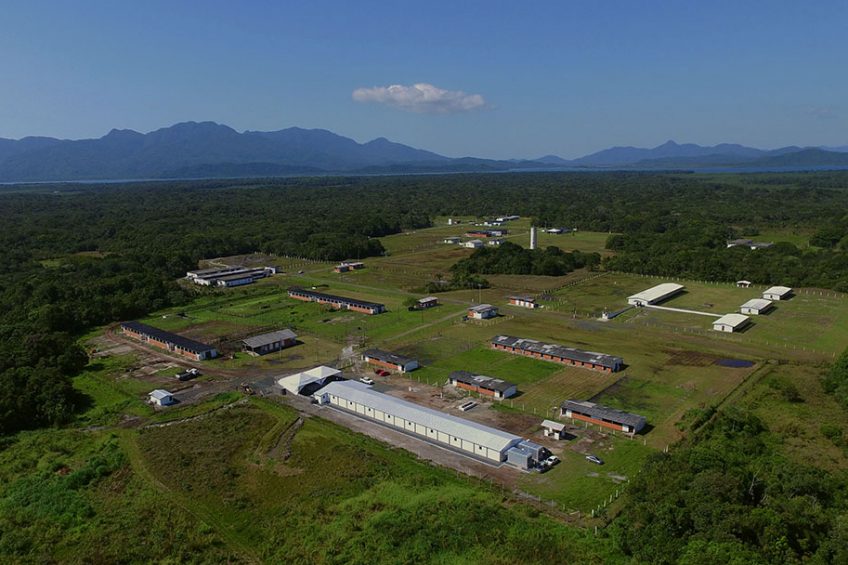Protecting Brazil from pig diseases

In terms of infectious diseases, Brazil can be proud of a long period of no infections from many serious pathogens. A major role in this success is played by the Cananéia Quarantine Station, which puts every incoming breeding animal to the test. How does that procedure work?
For the last 15 years or so, Brazil’s pig industry has been considered to be a bit of a ‘sanitary paradise’. While the US has been troubled by infections of Porcine Reproductive and Respiratory Syndrome (PRRS) and Porcine Epidemic Diarrhoea (PED), and Asia and Europe still face African Swin Fever (ASF) outbreaks, Brazil has no critical diseases in its productive areas.
One reason for that positive result in pig farming is the Cananéia Quarantine Station (Estaçao Quarantenária de Cananéia – EQC) in São Paulo state. Located on an island, the quarantine site for incoming breeding pigs has strict biosecurity procedures and a low infection risk from imported swine breeders. Charli Ludtke is technical director of the Brazilian Pig Producers Association (Associação Brasileira dos Criadores de Suínos – ABCS). She describes the structure and other efforts by the sector to keep its pigs healthy.
What is the EQC exactly?
“The EQC belongs to the Ministry of Agriculture, Livestock and Supply (Ministério da Agricultura, Pecuária e Abastecimento – MAPA) and is the only official quarantine for pig imports. The structure aims to protect Brazil’s herd health and minimises risk of disease entrance through the breeders imported by various genetic companies. All pigs arriving at the EQC are subject to continuous monitoring by the MAPA’s Official Veterinary Service, under clinical and laboratory tests, before they can be transported to populate certified pig breeding farms.”
What is the current structure?
“The EQC housed animals of other species (i.e. horses and ornamental birds) until it was revamped and reopened with the addition of new facilities in 2014. Currently, the structure has two sites. Site 1 has two areas, the first area having three houses, each containing 56 individual cages, with the capacity to house 168 pigs. The second area contains 22 pens with the capacity to house 292 pigs, bringing the total of Site 1 to 460 animals. Site 2 only has one shed, containing 21 pens and 108 individual cages, and a total capacity for 528 pigs.
The complex also has complete infrastructure for high sanitary control, such as disinfection for vehicles, a place for lodging and training staff and an effluent treatment station.”

How does the EQC operation work?
“The EQC has capacity for ten to 12 imports per year. Importing companies have to ask to be scheduled on the official calendar. After that, they must follow bilateral agreements and zoosanitary requirements, such as complying with quarantine periods and laboratory tests before boarding. Pigs arrive in Brazil by air transport at Viracopos Airport in Campinas city, São Paulo state. Then, they pass through federal revenue documentary procedures and veterinary inspection of live loads, carried out by the International Agricultural Surveillance Unit (Vigiagro-MAPA).
Once approved, they proceed to board into land vehicles that are sealed. Transport from the airport to the EQC is carried out on a scheduled route, avoiding detours and stops. At the EQC, vehicles (and drivers) follow disinfection procedures and must meet all requirements to prevent any waste leakage during transportation.
After that, pigs are quarantined for an average of 25 days and are submitted to clinical examinations and blood collection for laboratory tests.
The EQC Official Veterinary Service tests samples for Aujeszky’s Disease, ASF, Classical Swine Fever, brucellosis, tuberculosis, leptospirosis, Transmissible Gastroenteritis, PRRS and PED. During the quarantine, ABCS rigorously evaluates all breeding pigs to ensure they meet zootechnical requirements in order to be admitted to the National Genealogical Registry.
The ABCS Genealogical Registry Service has done this for over 50 years. The service is regulated by MAPA to certify the animal’s origin, breed and genetics. So, pigs gain an identity from this document, including performance data, genealogy, name of the farm, breeder and place of origin. With laboratory results and daily inspections approved, the quarantine is finished.
Then, the animals can go to the destination farms, accompanied by the Animal Transit Guide. The animals are destined for breeding in different regions and must have follow-up on-site inspections from MAPA.
After a batch leaves, the unit will undergo cleaning, disinfection and sanitary vacuum procedures in order to maintain biosecurity standards for the next batch.”

What is the volume of animals? And what are their origins?
“The main origins are the US, Canada, Denmark, France, Netherlands, among others. Regarding volume, it depends on what genetic companies are demanding. Normally, each EQC site receives an average of six pig lots per year. Thus, we can say that we deal with an average of 850 pigs every two months.”
Who is responsible for the operation?
“The EQC belongs to the ministry, which is officially responsible for the quarantine. However, there is a public-private partnership with ABCS and the Brazilian Association of Swine Genetics Companies (ABEGS).
ABCS is legally responsible for the genealogical record of pigs and processes the zootechnical inspection on all animals to verify that they are following the required standards (reproduction, characterisation of the breed). In addition, ABCS assists on documentation and prior preparation of the animals’ import schedule.
ABEGS, on the other hand, coordinates the swine genetics companies to harmonize procedures and carry out daily activities regarding biosecurity and animal health inside the EQC. This technical cooperation is essential for maintaining the EQC and the health status of the Brazilian herd.”

What is your opinion about the health status of Brazil’s pig herd?
“The health status of the Brazilian pig industry is very good, and the disease control and prevention measures guarantee high productivity as well. We have proven biosecurity in Brazil’s pig farming, and we can develop further. Several regions, for example, are expanding biosecurity investments after Senecavirus A had entered in Brazil. The EQC safeguards the protection of the national herd against exotic diseases such as PRRS and PED that caused serious mortality problems in the US, as well as ASF in Asia and Europe.
The EQC is a fundamental structure, as Brazil – as the fourth largest producer and exporter – needs to import its breeding pigs frequently to continue genetic improvement and maintain the competitiveness of the Brazilian herd.”
What is the importance of the unit in keeping Brazil free of ASF?
“We know that all domestic pigs and boar are susceptible to ASF and can carry the virus without showing clinical signs during the incubation period. The EQC mitigates risk factors during imports, because animals are one of the main routes for the disease. The disease transmission also includes uncooked food from three to six months, contaminated feed, vehicles, clothes, bags, and bites from contaminated insects.
The bottom line is that other measures apart from the EQC are also important, such as ensuring the quality of imported feed, surveillance in ports and airports, correct disposal of food waste from ships and aircraft and prohibiting entry of animal food in baggage.”











